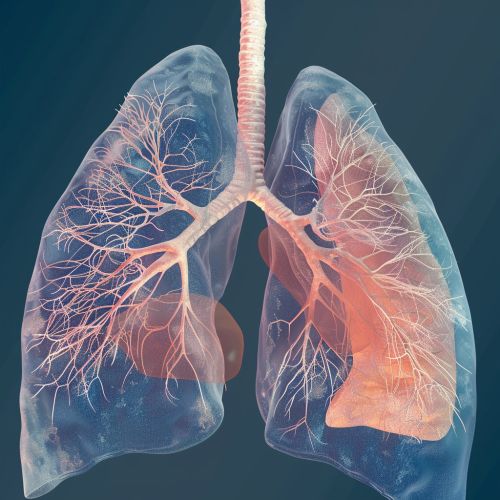Hering-Breuer reflex
Overview
The Hering-Breuer reflex, named after Ewald Hering and Josef Breuer, is a physiological reflex that controls the mechanics of breathing. This reflex helps regulate the volume of air inhaled and exhaled during respiration, thereby preventing overinflation or underinflation of the lungs.
Physiology
The Hering-Breuer reflex involves the activation of stretch receptors, also known as pulmonary stretch receptors, located in the smooth muscle of the airways. These receptors are sensitive to the degree of lung inflation. When the lungs are inflated to a certain volume, the stretch receptors send inhibitory signals via the vagus nerve to the medulla oblongata, a part of the brain that controls the rate and depth of breathing.


The medulla oblongata responds by inhibiting the signals that stimulate the diaphragm and intercostal muscles, causing them to relax and initiate exhalation. This mechanism helps to prevent overinflation of the lungs during forceful inhalation.
The Hering-Breuer reflex also plays a role in controlling the rate of breathing. When the lungs are deflated, the stretch receptors are not activated, and the inhibitory signals to the medulla oblongata are reduced. This allows the diaphragm and intercostal muscles to contract, initiating inhalation and increasing the rate of breathing.
Clinical Significance
The Hering-Breuer reflex has significant clinical implications, particularly in conditions that affect lung mechanics. For instance, in chronic obstructive pulmonary disease (COPD), the reflex may be impaired due to the loss of lung elasticity and airway obstruction, leading to hyperinflation of the lungs and increased work of breathing.
In neonates, the Hering-Breuer reflex plays a critical role in establishing regular breathing patterns. Premature infants may have an underdeveloped reflex, leading to irregular breathing patterns and periods of apnea. In such cases, mechanical ventilation may be required to support respiration until the reflex matures.
The reflex is also important during mechanical ventilation in critically ill patients. Overdistension of the lungs can lead to ventilator-induced lung injury. Understanding the Hering-Breuer reflex can help in setting appropriate ventilator parameters to avoid lung injury.
Research
Research into the Hering-Breuer reflex has provided valuable insights into the neural control of breathing. Studies have shown that the reflex is not only involved in the mechanical control of breathing but also plays a role in the chemical control of respiration. It has been suggested that the reflex may modulate the response to hypercapnia (elevated levels of carbon dioxide in the blood) and hypoxia (low oxygen levels).
Further research is needed to fully understand the complex interactions between the Hering-Breuer reflex and other components of the respiratory control system. This could potentially lead to new therapeutic strategies for conditions that affect breathing.
